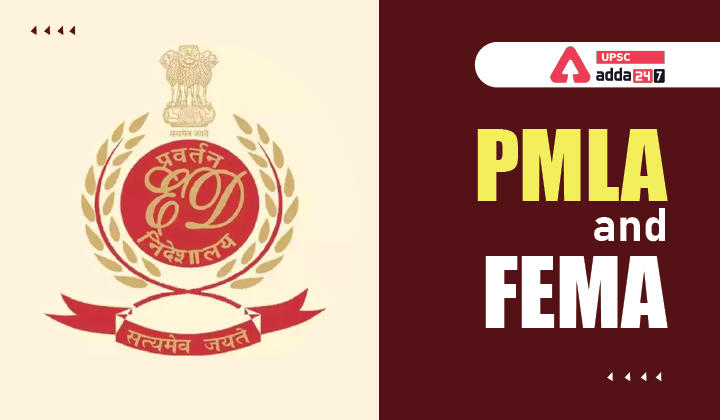Table of Contents
FEMA and PMLA- Relevance for UPSC Exam
General Studies III– Indian Economy and issues relating to planning, mobilization, of resources, growth, development and employment
FEMA and PMLA in news
Enforcement Directorate (ED) is witnessing an increase in cases under Foreign Exchange Management Act, 1999 (FEMA) and Prevention of Money Laundering Act, 2002 (PMLA)
WHAT IS MONEY LAUNDERING?
Money laundering is the illegal process of making large amounts of money generated by a criminal activity such as drug trafficking, terrorist funding, illegal arms sales, smuggling, prostitution rings, insider trading, bribery, and computer fraud schemes that produce large profits to appear to be originated from a legitimate source.
ISSUES OF MONEY LAUNDERING
- Money laundering and the terror financing are global problems that threaten security compromising the stability, transparency and efficiency of financial systems undermining economic prosperity.
- Developing countries or those with fragile financial systems can have devastating economic and social consequences.
In India, government incorporated a number of statutory measures to address the problem of money laundering which includes:
- The Income Tax Act, 1961
- The Conservation of Foreign Exchange and Prevention of Smuggling Activities Act, 1974 (COFEPOSA)
- The Smugglers and Foreign Exchange Manipulators Act, 1976 (SAFEMA)
- The Narcotic Drugs and Psychotropic Substances Act, 1985 (NDPSA)
- The Benami Transactions (Prohibition) Act, 1988
- The Prevention of Illicit Traffic in Narcotic Drugs and Psychotropic Substances Act, 1988
- The Foreign Exchange Management Act, 1999 (FEMA)
- The Prevention of Money Laundering Act, 2002 (PMLA)
THE PREVENTION OF MONEY LAUNDERING ACT, 2002
- Enacted as a response to India’s global commitment (including the Vienna Convention) to curb the menace of money laundering.
- PMLA was enacted in 2002 and it came into force in 2005, to curb money laundering (process of converting black money into white) and to provide for seizure of property derived from money-laundering.
There are mainly 3 objectives of PMLA
- To prevent and control money laundering.
- To confiscate and seize the property obtained from the laundered money.
- To deal with any other issue connected with money laundering in India.
FEATURES
- Punishment and Jail term: The Act prescribes that any person found guilty of money laundering shall be punishable with rigorous imprisonment from three years to seven years. The maximum punishment may extend to 10 years instead of 7 years.
- Powers of attachment of tainted property: The Director or officer above the rank of Deputy Director with the authority of the Director, can provisionally attach property believed to be “proceeds of crime”.
- Adjudicating Authority: It is the authority appointed by the central government which decides whether any of the property attached or seized is involved in money laundering.
- Presumption in inter-connected transactions: Where money laundering involves two or more inter-connected transactions. It is presumed that the remaining transactions form part of such inter-connected transactions.
- Burden of proof: A person, who is accused of having committed the offense of money laundering, has to prove that alleged proceeds of crime are in fact lawful property.
- Appellate Tribunal: It is given the power to hear appeals against the orders of the Adjudicating Authority and any other authority under the Act. Its orders are not final and can be challenged.
- Establishment of Special Court: To ensure speedy trial.
THE FOREIGN EXCHANGE MANAGEMENT ACT, 1999 (FEMA)
- The Foreign Exchange Management Act, 1999 (FEMA) is an Act of the Parliament of India that replaced Foreign Exchange Regulation Act (FERA) to consolidate and amend the law relating to foreign exchange with the objective of facilitating external trade and payments and for promoting the orderly development and maintenance of foreign exchange market in India.
FEATURES
- It gives powers to the Central Government to regulate the flow of payments to and from a person situated outside the country.
- All financial transactions concerning foreign securities or exchange cannot be carried out without the approval of FEMA. All transactions must be carried out through “Authorized Persons.”
- In the general interest of the public, the Government of India can restrict an authorized individual from carrying out foreign exchange deals within the current account.
- Empowers RBI to place restrictions on transactions from capital Account even if it is carried out via an authorized individual.
- As per this act, Indians residing in India, have the permission to conduct a foreign exchange, foreign security transactions or the right to hold or own immovable property in a foreign country in case security, property, or currency was acquired, or owned when the individual was based outside of the country, or when they inherit the property from individual staying outside the country.
WHAT CAN BE DONE
- More strict laws related to Anti-money laundering is necessary because money laundering tends to corrupt even the most professional players in the market.
- There is a need to sensitize the Private Sector about their role in anti-money laundering activities
- Continuous up-gradation and dissemination of information is necessary
- There is a need to build a balance between financial confidentiality and this confidentiality turning to a money-laundering haven.
- International regimes attempt to monitor or regulate international relations and activities.
- Intergovernmental groups have also taken action against the rising levels of global money laundering.
- Promotion of The Basel committee on Banking regulations and adopted a statement of principles that targeted money laundering.
- Promotion of The Vienna Convention creates an obligation for signatory states to criminalize the laundering of money from drug trafficking.
- Promote a regional approach to addressing problems, develop and maintain strategic relationships with other organizations.



 TSPSC Group 1 Question Paper 2024, Downl...
TSPSC Group 1 Question Paper 2024, Downl...
 TSPSC Group 1 Answer key 2024 Out, Downl...
TSPSC Group 1 Answer key 2024 Out, Downl...
 UPSC Prelims 2024 Question Paper, Downlo...
UPSC Prelims 2024 Question Paper, Downlo...




